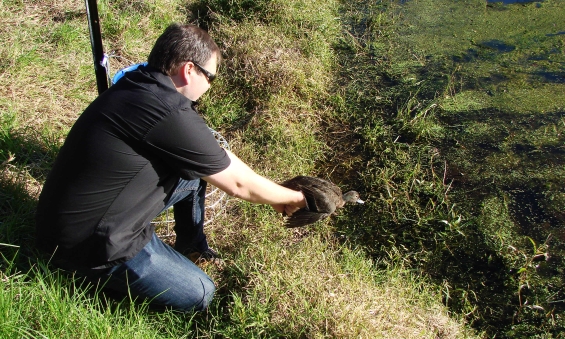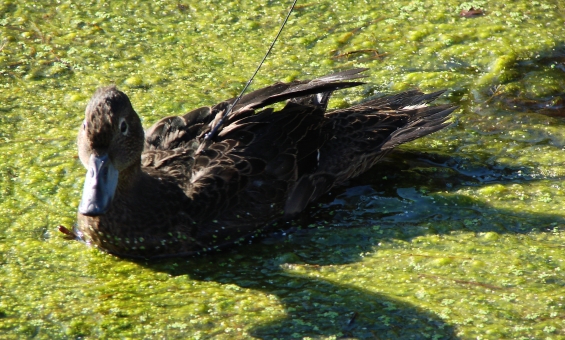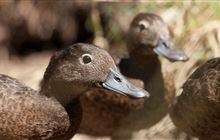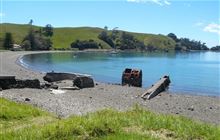Rare native duck released on Motutapu
Archived content: This media release was accurate on the date of publication.
Introduction
New Zealand’s rarest duck, pāteke, has been released on pest-free Motutapu Island in the heart of Auckland.Date: 29 May 2015
New Zealand’s rarest duck, pāteke, has been released on pest-free Motutapu island in the heart of Auckland.
The Motutapu Restoration Trust and DOC yesterday released 20 captive-bred pāteke on Motutapu, which is linked to Rangitoto by a short bridge.

Releasing a pāteke on Motutapu Island
Pāteke are unique to New Zealand and were common throughout the country 200 years ago. The arrival of cats, stoats and other predators plus habitat loss decimated pāteke.
By 2000, the pāteke population had shrunk to an estimated 700 birds at two locations in the North Island - Great Barrier Island/Aotea and Mimiwhangata Bay on Northland’s east coast.
A Pāteke Recovery Group, led by DOC, was established and is working with community conservation groups and iwi to secure the survival of pāteke.
Today the wild pāteke population has increased to an estimated 2500 birds. This has been achieved by establishing a breeding programme and releasing captive bred pāteke into suitable sites where rats, stoats and other predators have been eradicated or are being controlled.
"Motutapu is an ideal site to release pāteke,” says Motutapu Restoration Trust chair Brett Butland. "DOC has removed the predators that almost wiped out pāteke and the island has the right mix of habitat for this at risk native bird."
“Motutapu has 100 hectares of young native forest planted by Motutapu Restoration Trust volunteers plus vegetated wetland and farm pasture, a perfect habitat mix for pāteke.”
"We’re thrilled to have released our first 20 pāteke onto the island and thank Bayer New Zealand for funding the release. This is the start of a five-year plan in which our goal is to establish a self-sustaining population of 50 breeding pairs of pāteke on Motutapu," says Brett Butland.

Pāteke with a transmitter on it's back
Bayer New Zealand managing director Holger Detje says the company is delighted to provide funding for the pāteke release.
"As a life sciences company focused on improving the lives of people, plants and animals, we firmly believe in the great conservation work being done by the Motutapu Restoration Trust and its supporters. The release of these birds will not only add to the biodiversity of the island, but also provide Aucklanders with a unique treasure – right on their doorstep."
The birds released on Motutapu were bred by the Pāteke Recovery Group which has a network of 20 breeding sites spread from Dargaville to Invercargill.
"These birds were sourced from different breeding sites and held at the Isaac Conservation and Wildlife Trust’s centre at Peacock Springs in Christchurch where they were treated and screened for diseases. They were also fitted with transmitters before their release," says Pāteke Recovery Group Captive Coordinator Kevin Evans.
Air New Zealand flew the 20 pāteke in travel boxes from Christchurch to Auckland on a scheduled passenger flight, as part of a conservation partnership with DOC valued at more than $7 million. DOC transported the birds from Auckland Airport to Motutapu.
Since the partnership was signed in April 2012, Air New Zealand has flown more than 1300 endangered native birds and reptiles to new locations as part of the work to ensure the survival of our native wildlife.
"Creating a self-sustaining population of pāteke on Motutapu will be another significant step towards securing the survival of this unique native bird," says Kevin Evans.
"The hope is that pāteke bred on Motutapu will populate neighbouring predator free islands such as Motuihe, Rakino and Browns Island or Motukorea."
Ngātiwai is active in the captive breeding of pāteke as the programme sources birds from wild populations in the iwi’s rohe. Ngātiwai and Ngāi Tai ki Tāmaki, who have mana whenua status on Motutapu ,are working with DOC and Motutapu Restoration Trust to build a breeding population of pāteke on Motutapu.
Pāteke/brown teal release video
Motutapu Restoration Trust
The trust was stablished in 1994 to restore the ‘natural and cultural landscapes’ of Motutapu through the active participation of volunteers. At around 160 million years old, Motutapu is one of the oldest landforms of New Zealand. Motutapu Restoration Trust’s by line is ‘breathing new life into an ancient landform’.
Motutapu Restoration Trust seeks to restore a natural landscape on Motutapu similar to the one that rose out of the ashes of the Rangitoto eruption 600 years ago. It runs a year round volunteer programme involving the community in seed collection, nursery work, tree planting and weed control. Regular volunteer days take place on the first, third and fifth Sunday of each month, together with mid-week volunteer days, throughout the year. Motutapu Restoration Trust welcomes new volunteers keen to help ‘breathe new life into an ancient landform’.
Since Motutapu and neighbouring Rangitoto were declared pest free in August 2011 Motutapu Restoration Trust, DOC and Ngāi Tai ki Tāmaki have released five species of threatened native birds on Motutapu - takahē, Coromandel brown kiwi, tīeke/saddleback, shore plover/tuturuatu and whitehead/pōpokotea.
Motutapu Restoration Trust website
Contact
Nick Hirst, Media Advisor
Phone: +64 9 307 4846
Mobile: +64 27 704 7773


